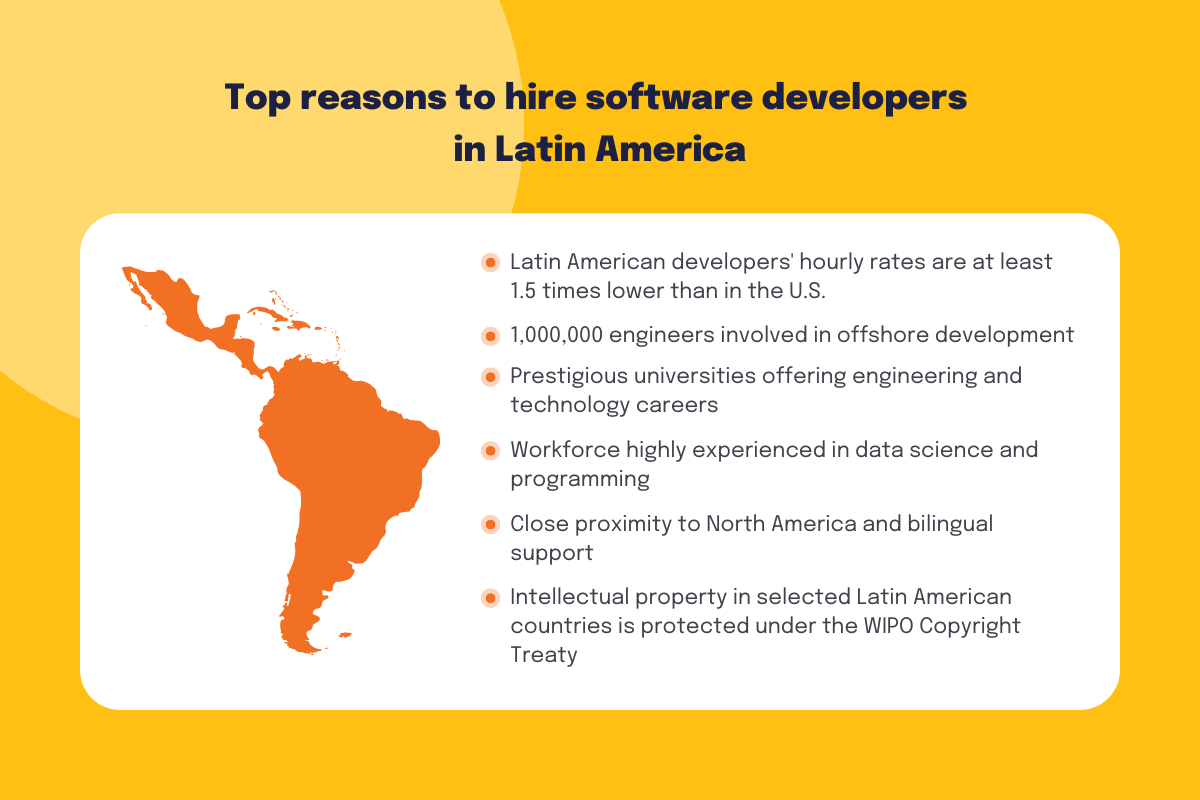Outsourcing software development has remained one of the main trends in the IT market during the last few years. There are many reasons why companies, organizations, and businesses decide to maintain software development teams overseas, but one of the most crucial is an opportunity to reduce development costs.
Over the past decade, the interest in outsourcing has shifted from Asian countries such as India, China, and Vietnam to Central and South America. Latin America has strengthened its reputation in the IT industry and has become a top outsourcing destination for software development. For example, North America has deliberately entrusted top tech professionals from Latin America with their IT routine instead of in-house US teams.
Companies consider offshore software development in countries such as Mexico, Chile, Argentina, Colombia, Brazil, Uruguay, and Costa Rica to have helped Latin America gain a leading role in software development outsourcing. Their main assets include high-quality IT services, real-time collaboration, travel proximity, and cultural similarity, which are all beneficial for business. Additionally, most Latin American software developers speak English fluently.
However, despite all the advantages of outsourcing to Latin America, there are also some pitfalls that can take a serious toll on a project or working process. In this article, we will showcase some of the pros and cons of outsourcing to Latin America as well as provide you with an alternative with increasing popularity.
Table of Contents
Why do American companies outsource software development to Latin America?
Countries like Mexico, Brazil, and Colombia have become attractive destinations to outsource software development due to lower costs, close time zones, and general closeness to the US in terms of culture. In addition, there are many skilled and educated developers who are proficient in popular and rare programming languages/technologies. Why else may you find this destination your final point in searching? Find out below.
Geographic proximity and time zone alignment
Latin America is much more convenient for outsourcing in terms of time zone alignment. The biggest disadvantage of collaboration with Chinese or Indian developers is the large time zone difference (approximately a 13-hour difference for US companies). In this regard, South America and its nearshore outsourcing companies are much more convenient to work with as the time difference is minimal. Latin American time zones allow you to have a team close by, communicate effectively with them, and get a faster response from your software engineers during regular business hours. It is much easier and faster to resolve any issues. Additionally, it should go without saying, but it’s crucial to check in on a team or be able to contact them to discuss project details. As a result, face-to-face meetings are easier to handle in similar time zones. Moreover, should the need arise, business travels are more affordable with non-stop flights to major cities such as New York, Houston, and Chicago.
Language proficiency
According to the latest research, some countries in South America have surpassed China’s level of English proficiency. These countries include Peru, Ecuador, Chile, Brazil, and Mexico. With the growing importance of English as the international business language, the tendency to invest more money in developing a good command of spoken and written English is common in Latin America. Therefore, the number of fluent speakers in the region has grown enormously thanks to diverse educational programs and initiatives. Hence, English fluency has helped software development in Latin American countries become a hub for IT outsourcing.
Education
Latin America has no shortage of IT programmers with a solid educational foundation. Therefore, it’s easy for industry professionals to maintain their outsourcing commitments. The workforce is highly skilled, and they provide clients with a wide range of services. Major tech giants like Microsoft and Hewlett-Packard have launched educational programs to assist Latin America in developing their IT skill set so developers can start their careers.
Technology and innovation thrive in Latin America
Remote working and digital transformation have decentralized innovation and technology hubs in Latin America. Many startups are now based outside international capitals, in smaller cities such as Cordoba in Argentina and Medellín in Colombia, each of whom is competing to become the region’s next Silicon Valley.
The flourishing technology in Latin America is impacting professional development programs for engineers, helping them gain experience in fast-paced environments.
What are the risks of outsourcing software development to Latin American countries?
Despite all the advantages, outsourcing software development to Latin America might be risky.
The risks include:
- More developers – harder to find the perfect one;
- Costs;
- Tax policies;
- Possible delays in development;
- Political instability.
Let’s walk through each option more precisely.
Tech talent number
It is true that there are plenty of accomplished developers in Latin America, and the number of IT professionals keeps significantly rising. However, due to the large numbers, it becomes very difficult to assess candidates thoroughly and accurately to determine their level of expertise. For example, in Peru, there are approximately 38,000 developers ready to tackle a new outsourcing order. Colombia has over 64,000 programmers, Chili 61,000, and Argentina has 16,000. As a consequence, you may end up hiring a developer who is less qualified because of being overwhelmed by the number of candidates. This could result in a lower-quality code impacting the organization’s overall working process.
Costs
Companies and businesses are willing to hire developers from Latin America to save money. For example, qualified developers in the United States earn approximately $85 to $160 per hour. However, in comparison, in Latin America, labor costs are much more reasonable. Therefore, companies can hire a skilled professional for $50 to $75 per hour. Nonetheless, developer salaries are steadily rising in Latin America as well. However, if companies and startups in the US want to cut down their expenses even further, there are even less expensive options. For instance, it’s possible to hire professionals from India or China for as little as $20–$50 per hour.
Browse 500+ Dev Teams Available for Hire
Tax policies
In 2022, Latin America introduced a series of reforms to strengthen and modernize its tax system. Different tax policies, double taxation treaties, and free trade zones can significantly hinder the outsourcing process to outsourcing to Latin America. Thus, taxation can be a major challenge for companies willing to outsource to the region. For example, with permanent collaboration with a Latin American outsourcing team, you are fully taxed as if your company had a branch there. Despite the fact that Brazil doesn’t tax permanent establishments, the country imposes foreign companies with indirect taxation. Furthermore, tax regulations for each Latin American country are very complex, so you should learn the specifics or find a trustworthy accountant or attorney to advise you and help you make the right decision.
Slow process
Some customers who have turned to software development services in Latin America also reported a lack of punctuality and significant delays in project performance and delivery. Many American customers expressed frustration with this lack of urgency. Also, Latin American developers are less disciplined and can often reject a job offer. Consequently, it can negatively influence the overall development process, especially if you work within tight deadlines.
The region’s political instability
The political situation is often rather unstable in Latin America. Governments in Venezuela, Ecuador, Nicaragua, and Bolivia are often (foreign) anti-business and, or at least, anti-American. This can be a substantial hindrance to American companies. As a result, acts of violence in the region can significantly impact Latin American IT outsourcing.
Is there an alternative to outsourcing to Latin America?
Luckily, it is possible to avoid all the above-mentioned risks and make the best out of outsourcing to Latin America as well as to other popular offshore destinations. The answer lies within tech marketplaces for offshore development talents, which function as a two-sided platform for hiring developers. For example, YouTeam offers a next-generation marketplace for easily building a remote team—and it’s much less time-consuming.
YouTeam has full-stack, back-end and front-end developers, and mobile development professionals at your disposal – a dynamic talent pool of 50,000+ engineers in top offshore destinations, including Latin America and Eastern Europe (Ukraine, Poland, Moldova). You can choose from the best offshore software development companies and the top development teams that suit your business objectives. In addition, before you assign a team to a project, you can meet the professionals to ensure you make the right decision.
All professionals are thoroughly selected by a team, so you shouldn’t worry about their quality, allowing you to channel your efforts elsewhere. Salaries typically range between $47–$75 per hour, which is much more cost-effective for many companies. Searching through YouTeam’s website, you’ll only find vetted, top-qualified talent.
YouTeam can help you hire remote developers within 48 hours.
Offshore software development in Latin America: FAQ
What is the hourly rate for software development in different Latin American countries?
Is Mexico a good place to outsource?
How to build trust with your offshore development team?
Which South American country is best for outsourcing software development?
Brazil. It is particularly well known for its large talent pool, with more than 7,000 companies in the software development and production sector and more than 12,000 companies registered in the IT services segment as of 2021.









